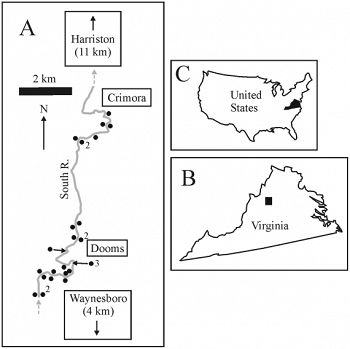Pizzuto, 2012
Predicting the accumulation of mercury-contaminated sediment on riverbanks—An analytical approach
Jim Pizzuto (2012)
Water Resources Research Vol. 48, W07518
-
Christina, INVESTIGATOR
Abstract
Figure 1. Location of the study area. Coring sites indicated by black dots in a. Multiple cores were taken at some of the sites (indicated by numbers in a).
Mercury was introduced into the South River, Virginia, as a result of industrial use from 1929 to 1950. To guide remediation, an analytical model is developed to predict the mercury inventory resulting from deposition of mercury-contaminated sediment on subhorizontal surfaces adjacent to the river channel from 1930 to 2007.
Sediment cores and geomorphic data were obtained from 27 sites. Mercury inventories range from 0.00019 to 0.573 kg m−2. High mercury inventories are associated with frequent inundation by floodwaters, forested riparian vegetation, and (at only four sites) unusually high sediment accumulation. Over the 10 km study reach, mercury inventories do not vary with downstream distance. The frequency of inundation at each coring site is determined from hydrologic data and a streamtube stage-discharge model. Water levels are exponentially distributed. A simple parameterization represents the enhanced ability of forested vegetation to trap mercury-contaminated sediments compared to nonforest vegetation. The calibrated model explains 62% of the observed variation in mercury inventories; 15 of the 27 predicted values are within a factor of 1.8 of the observed values.
Calibration indicates a mercury deposition rate during inundation of 0.040 kg m−2 yr−1 (95% C.I. 0.032–0.048), that forested areas accumulate mercury-contaminated sediment 3.05 (95% C.I. 2.43–3.67) times faster than nonforested areas, and that floodwaters deeper than 0.98 (95% C.I. 0.45–1.53) m do not accumulate suspended sediment or mercury. At four sites, floodplain accumulation of 0.8–1.2 m occurred over a period of 39 (95% C.I. 22–56) years, while sedimentation is negligible (mean: 0.1 m, median: 0.03 m) at other sites.
Citation
Jim Pizzuto (2012): Predicting the accumulation of mercury-contaminated sediment on riverbanks—An analytical approach. Water Resources Research Vol. 48, W07518. DOI: 10.1029/2012WR011906
Explore Further


